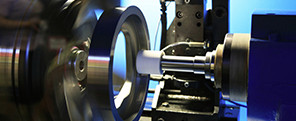Don't Waylay Your Machine Tools
with the Wrong Way Oil
By: Mark Copeland, Key Account Manager, Acculube
Oils are as varied as the machines they lubricate. But the many options available can create confusion when it comes to purchasing oils, particularly hydraulic oils and way lubes.
Why You Can't Use Just Any Hydraulic Oil in Slideways
Way oil, also known as slide oil, is a type of hydraulic oil with a tackifier, an additive that makes it adhere to surfaces. Way lube is ideal for vertical surfaces and anywhere machine parts move over the top of each other. It's commonly used as a lubricating oil for slideways found in planers, drills, saws, grinders, milling machines, and others.
Way lube holds in place, so slides are lubricated, reducing friction. Without a tackifier, hydraulic oil runs off (such as with a machine positioned up and down) or sticks to one side of the machine (such as where machine parts move over the top of the other) and then runs off.
The Wrong Lube Costs More
The best lube for any application is the one that works best with the least amount. The goal is to identify the right product, but not use too much of it. This approach saves money, preserves the machine parts, and lowers waste disposal costs.
Too Much Oil, Too Much Money
When oil doesn't stick, you have to keep adding more. A gallon of way lube will go much further lubricating a slideway than a gallon of regular hydraulic oil. Regular hydraulic oils cost about three dollars less per gallon than way lube. That initial cost savings is lost when you have to buy extra gallons. Don't be surprised if your annual purchases are more expensive when you use the wrong lubricating oil.
More Tramp Oil
Any oil used in a machine eventually ends up in the coolant as tramp oil. Tramp oil is a contaminant, and can enter your metalworking fluid from a variety of sources, including leaks from way, gear, spindle, and hydraulic oils, or oil on parts from previous operations.
Tramp oil causes lots of issues. It can shorten the life of your coolant, sicken employees, increase corrosion, cause staining, ruin machinery, and leave a residue on machine parts. It is a costly byproduct of your operations, and the more oil used, the more tramp oil you have to dispose of.
More Machine Part Wear
When friction isn't reduced properly, slideways and other machine parts wear out faster, causing machine downtime and increasing maintenance costs.
The Old Bar and Chain
Visit any online machinist forum and someone out there will inevitably claim you can save money by using your chainsaw’s bar and chain oil in your industrial machine. Don’t even consider it. Bar and chain oil and way lube have some similarities. However, the bar and chain oil in a $100 chainsaw made for tree cutting is not designed to work inside a quarter-of-a-million-dollar milling machine that does precision work.
Additives in bar and chain oil can harm your machine. And if that isn’t bad enough, batches of bar and chain oil can vary. Chainsaws don't require tight tolerances, so there's no need to be precise in manufacturing batches of its lubricating oil.
Identifying the Best Way Lube
To identify the best way lube for your machine application, start with a high-quality base oil and the correct quantity of tackifier.
How you use the machine can also affect the type of lubricating oil you need. For example, slideways moving four feet require a higher quality lubricating oil than one moving two feet.
Unfortunately, while the machine manual should indicate the thickness of the oil you need, it usually won't specify the type or quality of oil required.
So the options are: educate yourself on the different oil brands, or ask a specialist. Most major oil suppliers have specialists trained to evaluate your machine needs.
Oil is not just oil anymore. With the right knowledge, you can select the best oil type and brand for your
specific machine and applications, saving you money and maintenance headaches.
ABOUT THE AUTHOR: Mark Copeland is Key Account Manager for Acculube, a Dayton-Ohio based supplier of metalworking and manufacturing fluids to American manufacturers, machine shops and vehicle fleets.
NEXT ESSAY
 |
|
Get the best lubrication – and great advice maintaining your industrial machines and vehicles. Email Acculube or call us at 1.800.404.2570.
|
|


